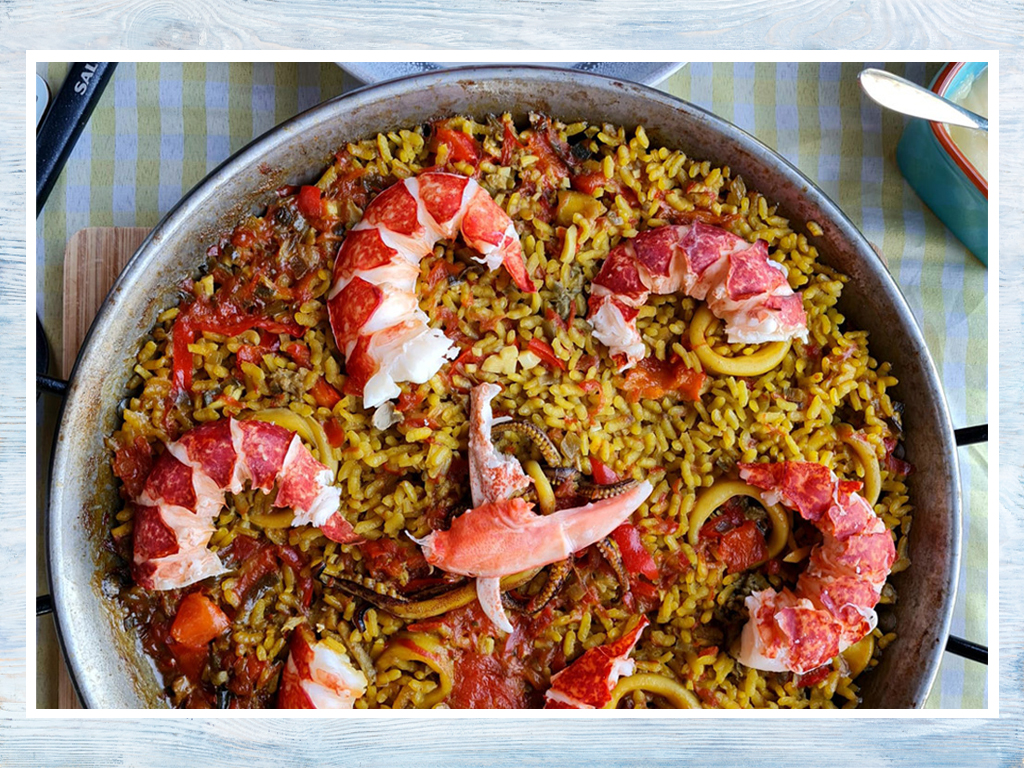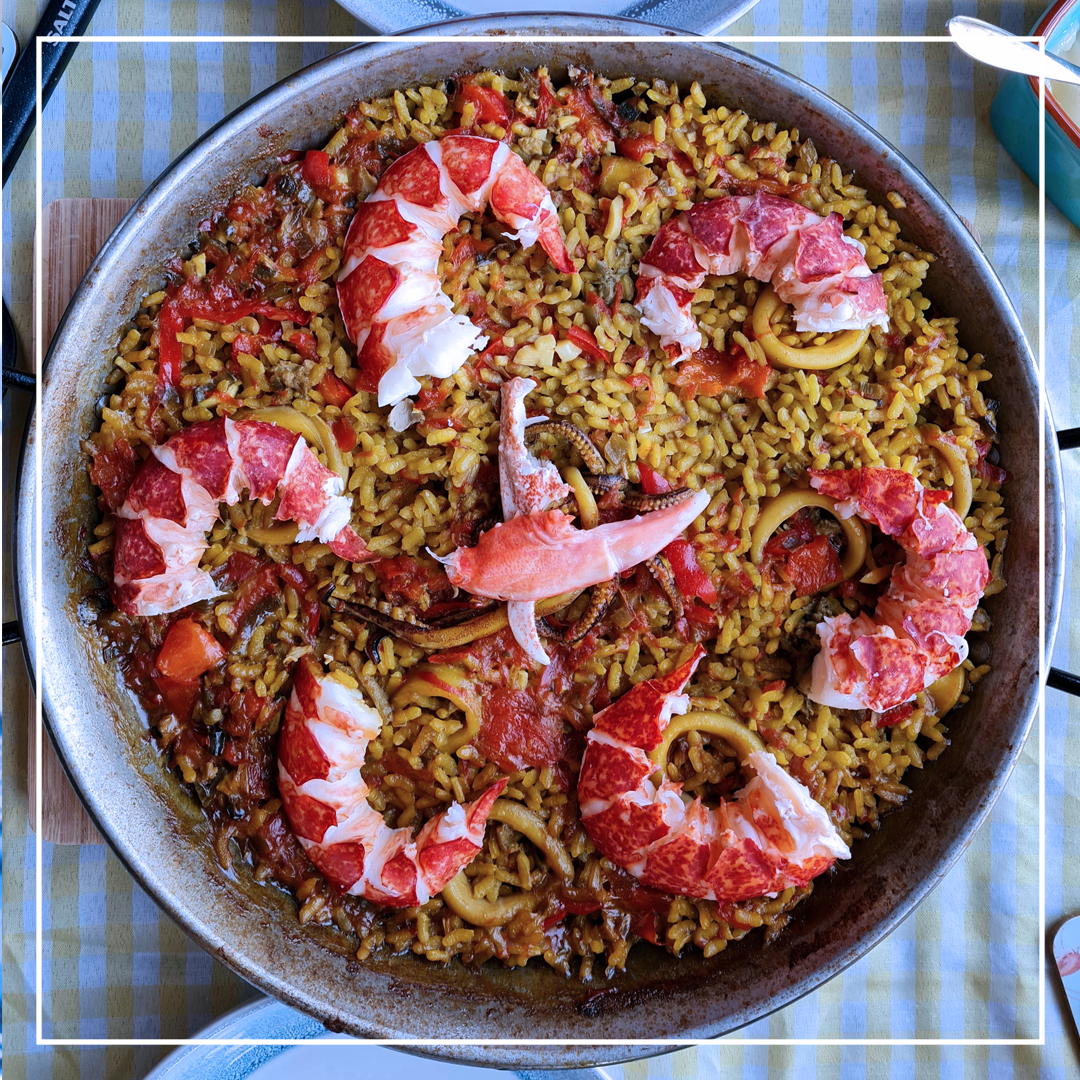We’re going to let you into a secret. When it comes to making the best seafood paella this side of Valencia we have an advantage – we have inside information. We’re friends with someone who lives in a small village just to the north of Valencia. She hasn’t told us all her secrets, but the knowledge she has shared makes our paella is the best this side of Valencia.

The best seafood paella recipe this side of Valencia
Description
Paella = summer. It's that simple.
Strictly speaking, paella is the name of the pan in which arroz (rice) is cooked with either seafood, meat, or traditionally, rabbit and snails.
Of course, being seafood lovers we only cook paella using the freshest seafood ingredients.
In terms of what seafood to use, pretty much anything works. We've cooked paellas with prawns, mussels, clams, cockles, monkfish, squid, cuttlefish, fillets of bream, bass and plaice, and even lobster (as in the pic above).
There's just three golden rules when it comes to making seafood paella:
- Use homemade fish stock
- Do not stir once the heat is turned up
- Always serve with homemade and aioli and never, ever lemon slices
Enjoy ☀️
Ingredients
Preparation
Stock
-
Make you stock in advance
Make life easier for yourself by making the fish stock in advanced. If you're struggling, try our best ever homemade fish stock recipe.
Preparation
-
Prepare your seafood
It goes without saying, but for a good seafood paella you should try and use the freshest seafood ingredients.
Prepare your seafood well in advance. For example, wash and clean any shellfish that you're planning to use. The last thing we want is any grit in the dish!
If using squid or cuttlefish, we like to marinate it in a little oil, salt, garlic and parsley.
Simply place your washed and prepared squid or cuttlefish into the marinade and pop it in the fridge for a few hours.
If using prawns, de-head and peel the prawns - but keep the heads and shells. -
Grate the tomatoes
Slice your tomatoes in half and grate the open side of the tomato. Discard skins.
-
Grate the pepper
Slice the pepper in half, deseed, and then grate.
-
Prepare the garlic and shallots
Finely slice the garlic and shallots.
Let's cook
-
Fry the prawn heads and shells
Place your paella pan over a low heat and allow it to get warm before adding the olive oil.
The amount of olive oil depends on the size of a pan. For a small, two-person pan add two tablespoons.
Don't let the oil get too hot. We need to stay in control of frying the prawn heads. If too hot, everything becomes a touch too sticky.
Fry the prawn heads and shells for around a minute or so. Push down on the heads with the back of a spoon to release all of the flavours.
Remove all heads and shells from the pan. If it's all looking a little dry, then add a touch more oil.
The oil only needs to take a slight orange hue, we don't want it browning at all.
-
Fry the shallots and garlic
Ok, now were ready to make the most of that delicious prawn-flavoured oil.
Increase the heat a touch.
Place the finely sliced shallot into the oil.
Wait for about 30 seconds, and then add the garlic.
Cook for a minute or so - do not brown!
Try to keep everything cooking in a nice, calm manner. If the pan is making too much noise, or spitting oil all over the place, then we're too hot.
-
Add the pepper and tomato
As the garlic and shallots just begin to colour were ready to add the grated pepper and tomato.
At this point, increase the heat to medium.
Add the pepper and tomato and give everything a quick stir.
Start to gently warm your fish stock in a separate pan.
-
Add the (some of) the seafood
Now we're really cooking.
When adding your seafood, think logically.
Monkfish will take longer to cook than a mussel for example.
We always put our prepared squid into the pan at this stage, for as we all know - squid should be cooked quickly, or for at least 15 minutes.
We'd also start to cook any fillets of fish that we're using.
Any shellfish (clams, mussels, cockles, etc) and prawns go in after the next two steps.
-
Add the stock and the rice
Once the stock is warm, ladle it into the paella pan.
Keeping adding the stock until it the level reaches the rivets of the pan.
Next, grab your sack of rice and draw a cross (+) in the pan with the rice.
This method will give you the exact amount of rice needed for the size of the pan.
-
Add the saffron and paella colouring
With our stock bubbling away in the paella pan we can now add the saffron.
Place it into the simmering stock and give it a stir.
Next, do the same with the paella colouring. If you're struggling to find paella colouring, then try this one that's available at Amazon.
The colours of the Spanish flag should start forming.
-
Add the shellfish
With our paella beginning to take shape we can now add the shellfish.
Less is more when it comes to your paella pan and the amount of shellfish. And don't forget, the rice will continue to swell - so we we don't want any seafood tumbling over the edge!
Give everything a quick taste. Don't be tempted to add any salt at this stage, let the shellfish release their salty goodness first.
-
Paella perfection
We've reached the crucial stage.
Any good paella is judged by its socarrat or crust.
To perfect a crispy, caramelised crust of absolute beauty we need to do two things.
Firstly, crank the heat up.
Secondly, resist every urge to stir the dish. DO NOT STIR - just leave well alone.
Wash the dishes, prepare dessert, or paint a gentle watercolour scene - basically do anything but stir the paella.
If things begin looking a little dry, and the rice isn't yet cooked, simply ladle in a touch more stock.
Normally, our paella is ready between 12-15 minutes after cranking up the heat.
-
Let the paella rest
As the Spanish say, 'after all that drinking, the paella needs a little rest'.
Once the rice is cooked, turn off the heat and cover the paella with a kitchen towel.
Let it sleep for 5-10 minutes.
-
Finishing touches
Like a magician unveiling his latest trick, swipe away the kitchen towel to reveal the best paella this side of Valencia.
If you want to be a true paella aficionado, then serve with some homemade aioli and nothing else (and definitely not lemon wedges!)
Enjoy!




